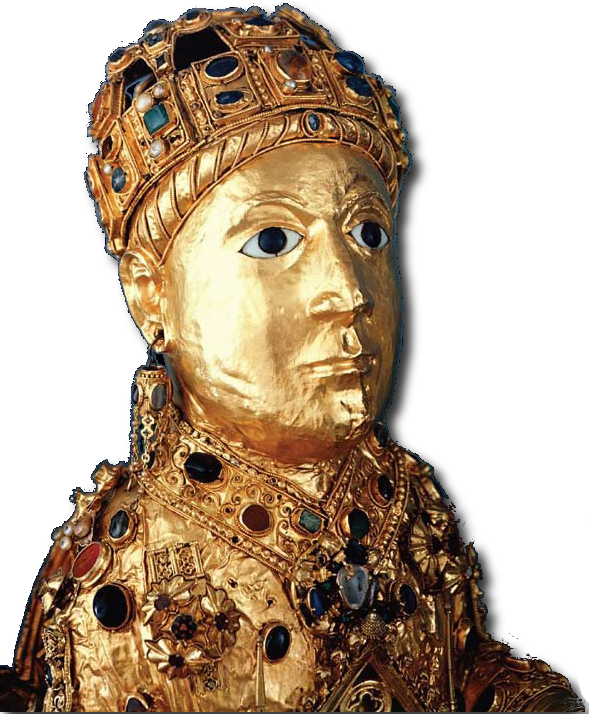 |
MedievalEuropeOnline
the web home of Medieval Europe: A
Short History
|
Clotilda, Queen of the Franks (470–548)
(This biographical sketch was deleted from the 11th edition, but it is available to you here.)
Clotilda’s life wove together old worlds and new, for she was born
when the last Roman emperor ruled in the West, was married as a young
woman to the Frankish king Clovis, and was recognized as a Christian
saint after her death.
Clotilda’s mother, from the old Roman aristocracy of Gaul, was a
Catholic Christian, but her father represented a rougher sort. He was
son of the king of Burgundy, a Romanized barbarian, and like most
Burgundians, he was an Arian Christian. Clotilda was raised in her
mother’s faith. When she was in her teens, her uncle Gundobad murdered
her parents, exiled her sister (who became a nun), and kept Clotilda
in his home, perhaps because her intelligence and beauty promised a
good marriage.
If her uncle had hoped to marry her to an ally, he was to be
outfoxed. Clotilda secretly began to arrange her own marriage. It was
no love story. When Clovis, king of the Franks, heard about the
unmarried niece of the powerful Gundobad, he sent an envoy to offer
marriage. The envoy disguised himself as a pilgrim and secretly
presented Clotilda with a ring and other gifts. Clotilda hid these and
sent a message back to Clovis. She appreciated his proposal, but she
asked him to keep it secret. And, although she expressed concern about
Clovis’s paganism, she added, “Whatever my Lord God orders, I will
do.”
A year later, Clovis made his move. He asked Gundobad to send
Clotilda to him so that their marriage could be finalized. Gundobad,
still in the dark about the proposal, reacted with fury. But when he
found Clovis’s gifts stashed away in a corner of his treasury, he
considered these to be evidence of an irrevocable betrothal and
angrily allowed the marriage to go forward. Clotilda probably first
met Clovis just before they were married in Soissons in 493, when she
was no more than 20 years old. All told, this was a hardheaded match.
Made more through negotiation than courtship, it was a common
arrangement for the aristocracy of the day.
Brought up in a court of Arian Christians but faithful to Catholic
Christianity, Clotilda now found herself married to a pagan. She is
said to have started converting Clovis on their wedding night, with a
well-timed lecture on Christianity. (With somewhat less charitable
intent, she also harangued him about the importance of avenging her
parents’ murders.) When their first son was baptized as a Catholic
Christian and soon thereafter died, Clovis blamed his wife’s faith,
but Clotilda was soon pregnant with another heir. That son, too, was
baptized, and he lived, a fortunate turn for the future of Catholic
Christianity among the Franks. Clotilda continued to press her husband
to convert, and after three years of marriage, Clovis finally gave in.
He chose a strategic moment. Losing a disastrous battle against the
Alemanni, he raised his eyes to heaven and invoked the god of his
wife, shouting “Jesus Christ, you who Clotilda maintains is the son of
the Living God . . . if you will give me victory over my enemies, then
I will be baptized in your name.” In the next instant, the Alemanni
turned and fled. Clovis accepted baptism, along with 3,000 of his men.
He thereby achieved domestic peace (no more late-night lectures from
his wife) and also ensured that the Franks—first among the barbarian
tribes—accepted Catholic Christianity. At Clotilda’s further urging,
Clovis became a firm ally of Catholic Christianity, destroying pagan
shrines, building churches, and funding a variety of religious
projects.
This story of female persuasion and Catholic triumph comes from later
Frankish histories that weave together fact and fiction. Historians
today would tell the tale differently. Clovis’s battlefield conversion
recalls Constantine at the Milvian Bridge too neatly to be credible,
and it now seems that Clovis might have been an Arian Christian, not a
pagan, before Clotilda persuaded him to accept Catholic Christianity.
In any case, Clovis had good political reasons to accept his wife’s
faith, for his Franks had to coexist with a Gallo–Roman population
faithful to Catholic Christianity. And because his choice of Catholic
Christianity distinguished the Franks from all other barbarian tribes,
Clovis positioned his dynasty as champions against the Arian
Christianity embraced by the Burgundians, the Visigoths, and others.
Yet, although Frankish histories might have emphasized Clotilda’s
pious work over Clovis’s political savvy, both seem to have worked
together to the same end: the conversion of the Franks to what
eventually became orthodox Christianity in the West.
Like many aristocrats of her day, Clotilda lived between barbarian and Roman cultures and among many different faiths. Like many aristocratic women, Clotilda forged active links between these diverse traditions, and her work as a domestic proselytizer was not unusual. Both the Lombards and Visigoths eventually abandoned Arian Christianity thanks to pious Catholic queens married to Arian husbands. The later conversions of Bohemia, Poland, and Russia would also come about, in part, by the marriages of Christian women to pagan kings. But Clotilda would have likely taken most pleasure in the efforts of her great-granddaughter Bertha, Christian wife of the pagan King Ethelbert of Kent. When Queen Bertha welcomed Christian missionaries to Kent in 579, she nurtured a fledgling faith that would eventually take hold throughout Britain, as it had almost a century earlier among the Franks.